Page 143 of 402
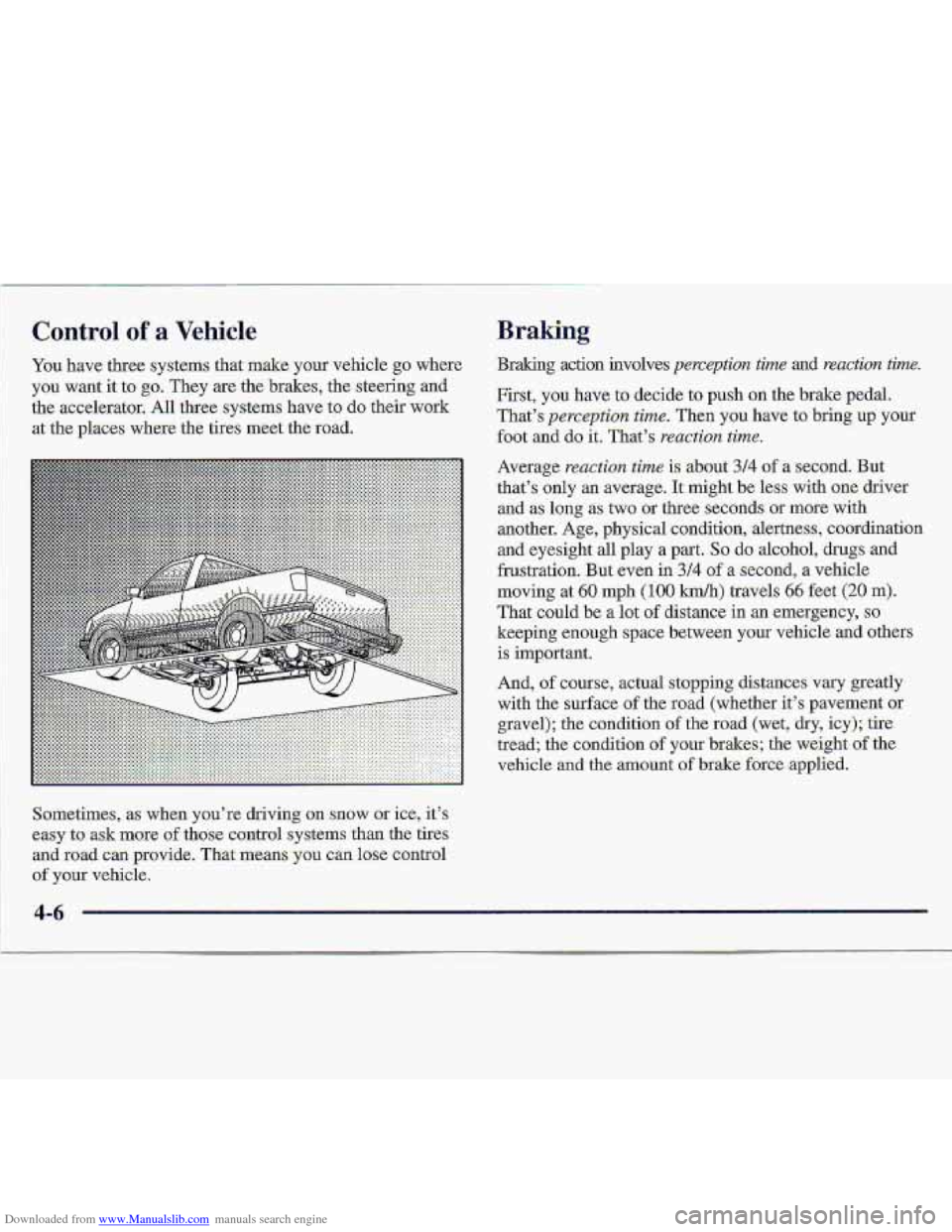
Downloaded from www.Manualslib.com manuals search engine You have three systems that make your vehicle go where
you want it to
go. They are the brakes, the steering and
the accelerator. All three systems have to do their work
at the places where the tires meet the-road. Braking action involves
perception
time and reaction time
First, you have to decide to push ob the brake pedal.
That’s
perception time. Then you.have to bring up your
foot and
do it. That’s reaction time.
Average reaction time is -about 3/4 of a second. But
that’s only an average. It might
.be less with me driver
and
as long as two or three seconds or more with
another. Age., physical condition, alertness, co.ordinati.on
and eyesight
all play a part. So do aIcohol, drugs and
frustration.
But even in 314 of a second, a vehicle
moving at
60 mph (100 km/h) travels 66 feet (20 m).
That could be a lot of distance in an emergency, so
keeping -enough space between your vehicle and others
is important,
And,
of course, actual stopping distances vary greatly
with the surface
of the road (whether it’s pavement or
gravel); the condition
of the road (wet, dry, icy); tire
tread; the condition of your brakes; the weight of the
vehicle and the amount
.of brake force applied.
Sometimes,
as when you’re driving on snow or ice, it’s
easy
to ask more of those control systems than the tires
and road can provide. That means you can lase c.ontrol
of
your vehicle.
4-6 .-
Page 144 of 402
Downloaded from www.Manualslib.com manuals search engine Anti-Lock Brakes (ABS)
Your vehicle has anti-lock bmk& (ABS). ABS is an
advanced .electronic braking systeni that will help
prevent a braking skid.
When you start your engine and begin to drive away,
your-anti-lok
brake system will check. itself. Yau may
hear
a rnsrnentary motor or clicking-noise, w-file this ‘test
is going on. This is normal.
If your-engine ever stqs while you’se driving, brake
normally
but do;n’:t pul~ip your brakes. Ifyou do, th-e
,p%ed-al may get hard-er-to puGh .down. If -your.engi-ne
‘stops, you will-s~tal have some power assist. B:ut
you will a-se it when you brake; Once the power.asskt is
used up, it may take long-er to stop afid thelljrake pedal
will
.be .harder to zrush.
ANTI - LOCK
If there’s a problem with the.
anti-lock brake system, -this
war‘i&g.Iight will stay an.
See. “Anti-Lo& Brake
System
Warning Light” in
th.e Index.
4-7
Page 145 of 402
Downloaded from www.Manualslib.com manuals search engine Here’s how anti-lock works. Let’s. say the road is wet.
You’re driving safely; Suddenly-an animal jumps out
in
front of you.
1 You slam on the brakes, Here’s what happens with ABS.
A computer senses that wheels are slowing down. If one
of the wheels is about to stop rolling, the computer will
separately work the brakes at each front wheel and at the
~ rear wheels.
The anti-lock system em change the brake p~essure faster
than any driver could. ?%e computer is programmed to
make the most of available tire and road tronditions.
You cansteer around the obstacle while braking hard.
As you brake, your computer keeps receiving updates- on
wheel speed and controls braking pressure accordingly.
Page 146 of 402
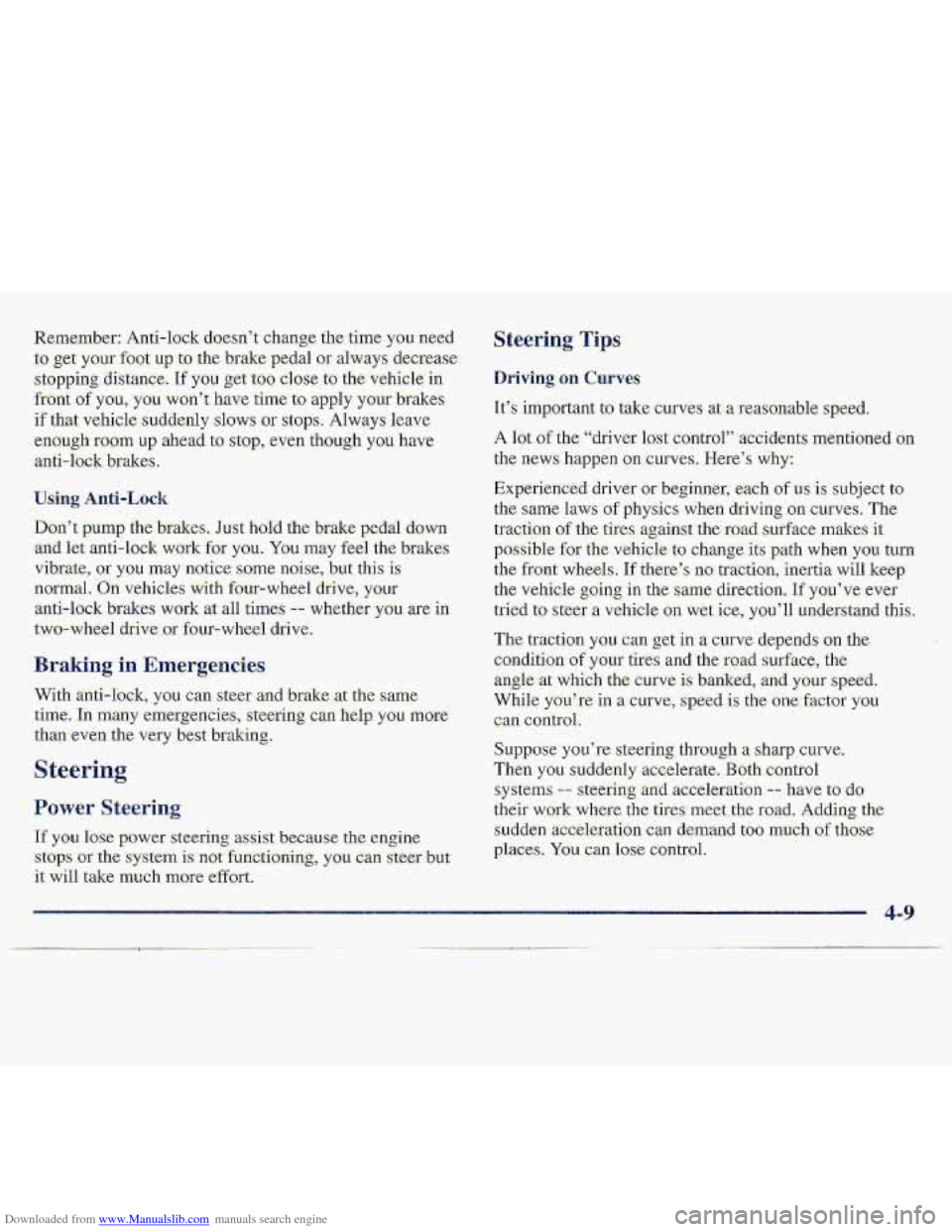
Downloaded from www.Manualslib.com manuals search engine Remember: Anti-lock dsesn’t change tbc- -time y.ou :need
:to get yo.ur fo~t up to .the brake ped,ai or always decrease
stopping
diskan&. If.you get-to6 cl~,se to thcvehicle in
front of YOU; you won’t have time to apply your brzikes
If.th:at vehicle suddelily .slows or siop-s. Always i-eave
e.nough mom up ahead to si.op, even though you have
anti-lockrbpkes.
U.s,ing.Anti.-LthA
Don’t pump the’bisakes. Just hdd the brake pedzl down
and let anti-lock wark..fox you. You ‘may feel the brake.$
vibrate., or you-may notice som-e noise, but this is-
::normal. Ofi vehicles Mth-four-wheel drive, your
;anti-lockbrakes work at all times- -- whether ,you are in
two-wheel driveor fuur-wheel:&.ive.
Braking in Emergencies,
With m-ti-lock, you can steer and brake at thc same
.time-. In many emergencies., st.eering can kip, you more
than even the very $est braking.
Power Steering
If you lose p~wer steeringatssist because the e.ngine
stop;s or the system is not fiw.dt?orriag, you can ste.er .but
it will take much more effort.
Steering Tips
It’s important to take c.urv.es at a reasonable sp-eed.
A lot of the “drivet lo‘st ci3ntml”‘accidents meritionedl ~li
the slews happen on curves. Here’-s why
Page 150 of 402
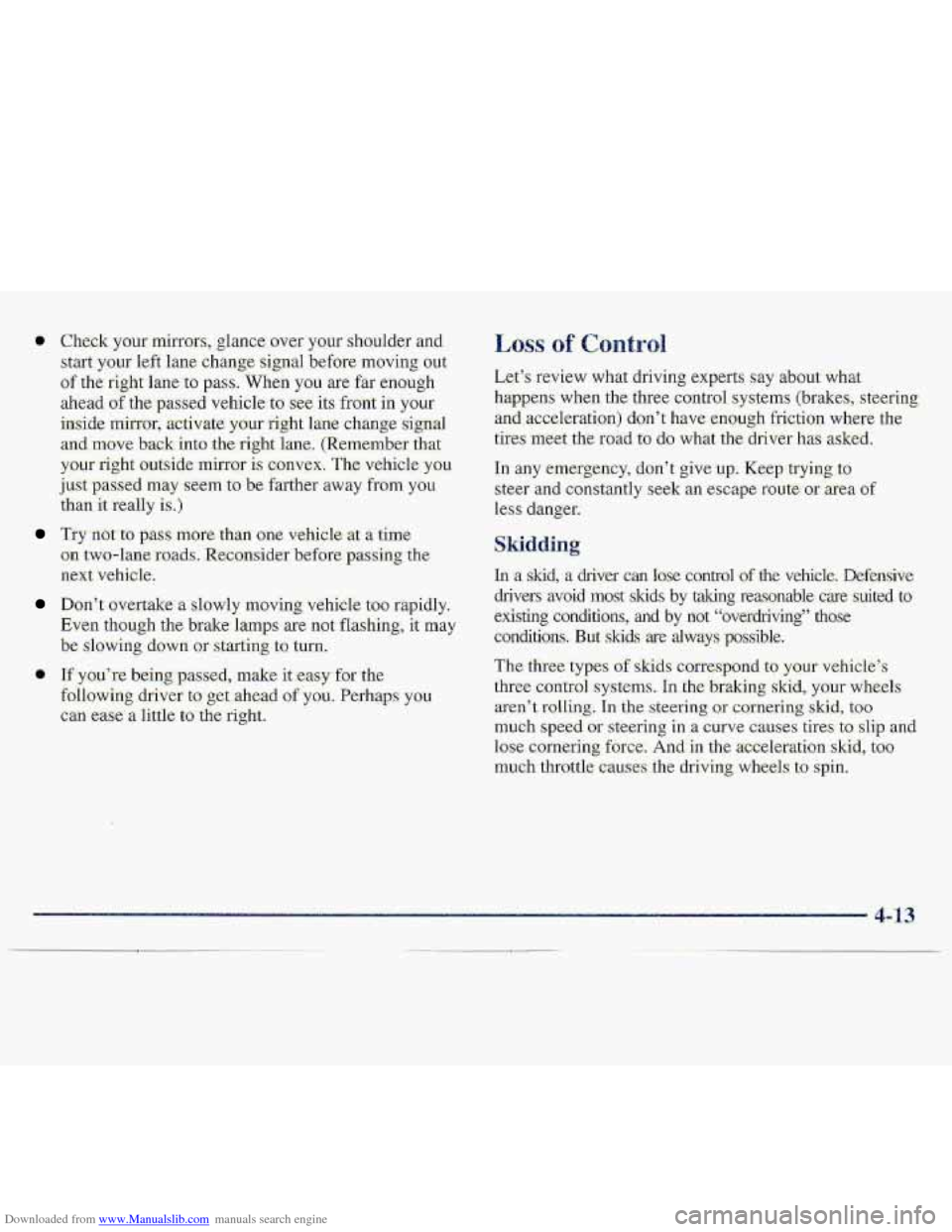
Downloaded from www.Manualslib.com manuals search engine * Check your mirrors, glance over your shoulder and.
start your left lane change
signal before-moving out
of the right.lane to pass. When you are far enough
ahead
of the passe.d vehicle to see its front in your
inside -01, activate your right lane change sigmd
and-move back into the.
ri,ght lane. (Remember that
your-right outside ,mirror is convex. The vehicle you
juslpassed may
seem to be farther away from y6u
than it really is.)
Tfy not co p.ass mufe ,than one vehicle ,at a time
on two-lane’roads. Reconsider before passing the
next vehicle.
D.on’:t overtake-.a slowly moving vehi-de too rapidly.
Even though
the brake -1amp.s are not flashing, it m.a.y
be slowing down or starting to, turn.
Qi If+ you’re being .passed, make it easy- for the
fallowing driver to
get..ahead .of you. Perh,aps you
can ease.&
little to the right.
Let’s review what driving expmts s-ay about what
happens when the thre.e
con.trol systems- (brakes., steering,
and,acceleration) don’t
have enough friction where the
tifes ”meet the road to do what the drivt?r has asked..
In any emergency, don’t give up Keep trying to
steer and constantly seek
an escape route-or aea of
less danger.
In a. skid, a driver cn lose control of .the vehicle, Defensive
drivers .avoid
most skids by taking reasonable care suited t9
existing conditiolrs, and by not “overdriving” those
conditions.. But- ,&ids
are always -pa.ssible.
The three typcis of skids correspond to your vehicle’s
three
c’0ntro1 syst,erns. In. the. brakifig skid, y0.m whe.eIs
aren’t rpl.ling. Ln the steering or- cornering skid, too
much speed or steering in a curve causes tires: to slip and
lase cornehg, foxce,. And. in the acceleration skid, too
much throttle causes the driving wheels- to spin.
4-13
Page 151 of 402
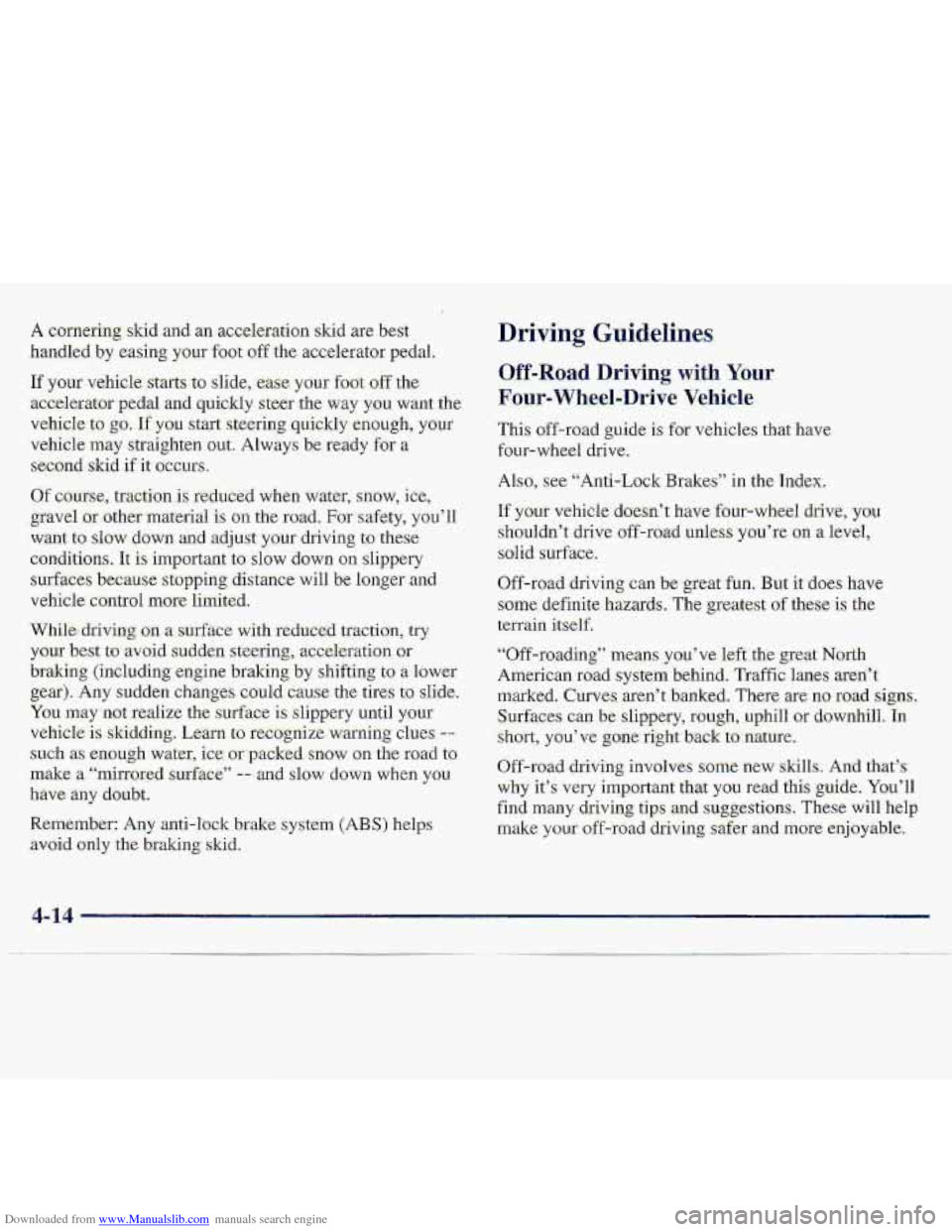
Downloaded from www.Manualslib.com manuals search engine A cornering skid and an acceleratioa skid .are best
hand1e.d by easing your foot off the accelerator pedal.
Driving Guidelines.
Off-IC0a.d Driving with Your
Four-Wheel-Drive Vehicle..
This off-road guide is for vehicles that have
.four-wheel drive.
Also, see “Anti-Lock Brakes” in the Index;
If your vehicle doesn’t have :four-wheel drive, you
shouldn’t drive off-road unl.es.s-you”re on a letel,
solid surface.
Off-road driving can be great fun. But it does have
some definite hazards. The greatest of these is the
terrain itself,
“Off-roading” means
.you’ ve left .the great North
American road system behind. Traffic. lanes arerft
marked. Curves aren.’t.Ij;znked. There are no road -sigm.
Surfaces can be slip-pery, rouqh, uphill or &~wnMl. In
-short, you’ve gone. ri.ght ba to nature.
off-road driving involves soni new skills. Aad tbat.’s-
why it’s very important that you read this guide. You’ll
find many driving tips and suggestions. These will help
make your off-rbad driving safer and more enjoyable.
4-14
Page 158 of 402
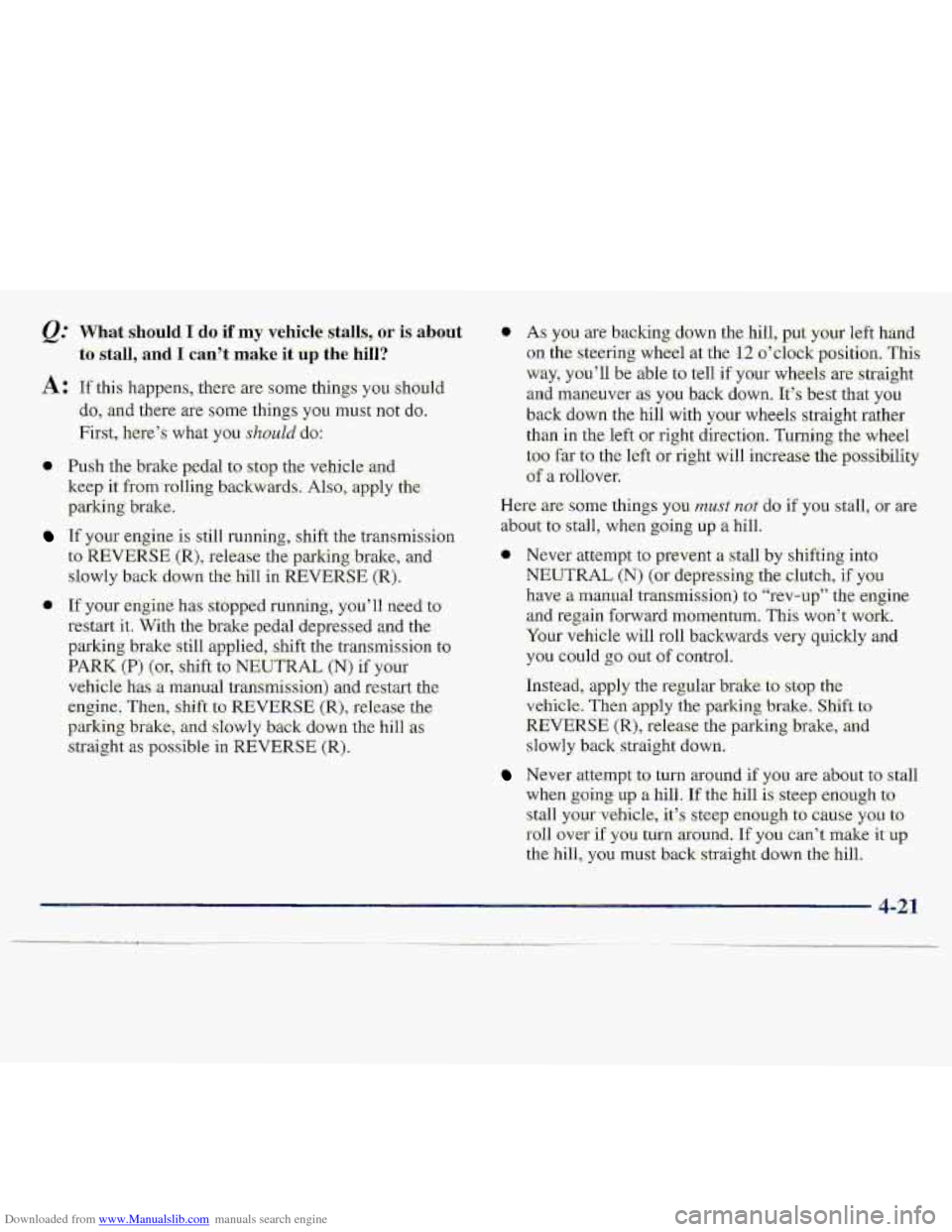
Downloaded from www.Manualslib.com manuals search engine QZ What.shou1.d I do if my vehicle stalls, or is about
to stall,
and I can’t make it up the hill?
A:- If this happens, .thexe are some things you should.
do, and there are some things
yo11 must not do.
First, here’s what you slzould do:
0 Push the brake pedal to stop the vehicle and
keep it from rollin-g backwards. Also,, qp:ly the
parking
brake.
2f your engine is still running, shift the transmission
to REVERS-E (R), release the parking brake, arid
slowly back down the hill in REVERSE (R).
If your engine’has stopped running, you’ll need to
restart it. With
the brake pedal depressed and the
parking brake still applied, shift
the transmission to
PARK (P) (or, shift to NEUTRAL (N) if your
vehi-cle has a manual h-ansmi.ssion) and restart the
engine. Then,
shift-to REVERSE (R), release the
parking
brake, and slowly back dow’n the hill as
straight as possible in REVERSE (R).
Insteixd, apply the regula- br.&e: to st-op the
vehicle.
Then apply the p.aTki-ng:brake. Shift to
REVERSE (R), release the parking -brake, and
slowly back straight down.
Never attempt to turn around if you are about to stall
when going up a hill. If the hill is steep eno.ugh to.
stall your vehicle; it:s steep enough to Game yon PO
1-011 over X you tuyn .aTaund. If-you c;an”t. make it up
the hill, you must back straight down the hill.
4-21
Page 159 of 402
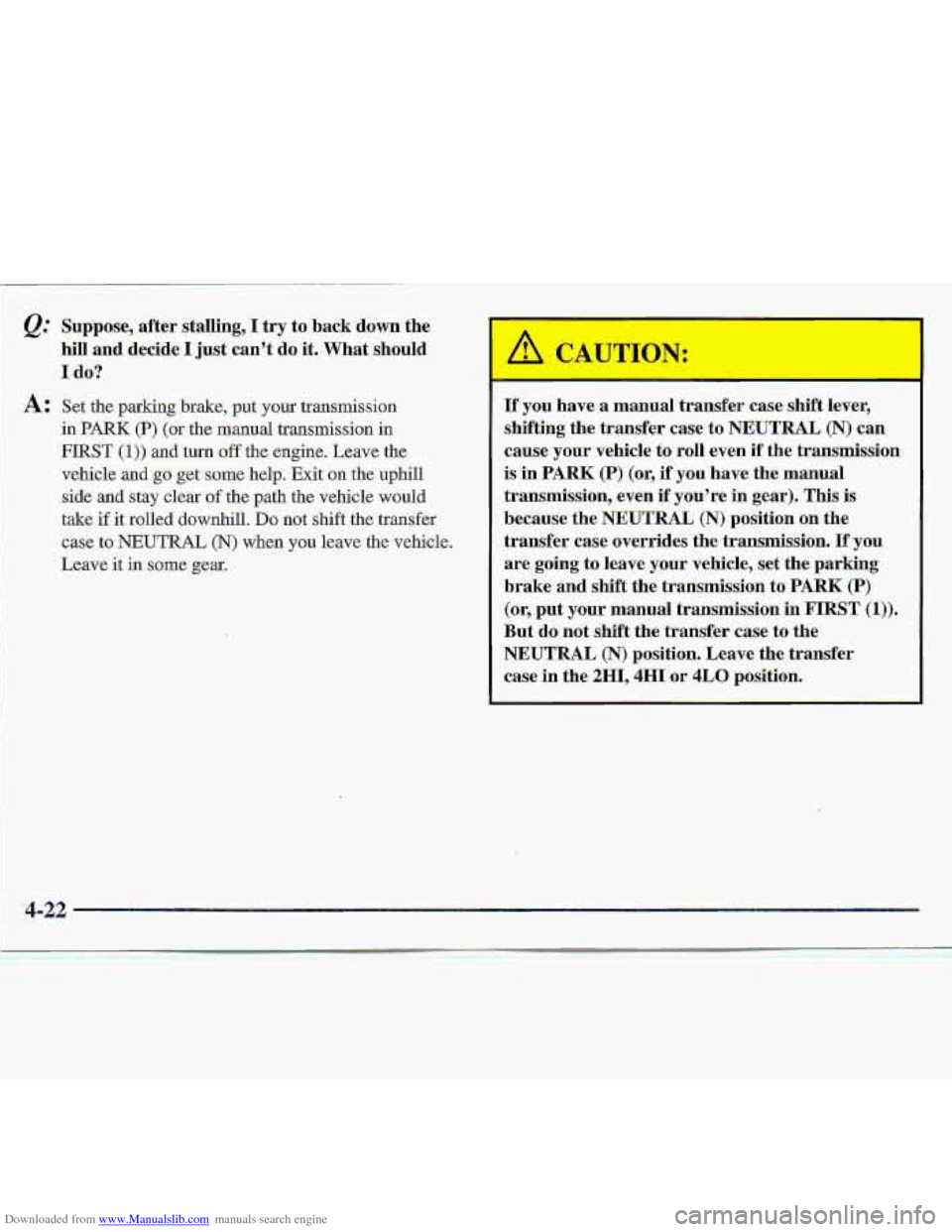
Downloaded from www.Manualslib.com manuals search engine Q.' S.uppose, after.stalling, I try to back down the
hiIl and decide I just can't do it. What should
I do?
A: Set the. parking brake, put your trammission
in PAW (P) (or the manual transmission in
FIRST (1)) and turn-off the engine. Leave the
vehicle and
go get-.some help. Exit on the uphill
side.
md stay cl&xr of the path the vehicle would
take
if it rolled downhill. Do not shift.the transfer
case to NEUTRAL (N) when you leave the vehicle.
Leave it in some gear.
If you have- a manual transfer case shtft lever,
shifting the transfer case
to NEUTRAL (N) can
cause your vehicle to roll. even if the transmission
is
m PARK (P) (or, if you have the manual
transmission, even
if you're in gear). This is
~ because the NEUTRAL (N) position on the
transfer case overrides the transmission.
If you
are going
to leave your vehicle, set the parking
brake
and shift the transmission to- PARK (P)
(or, put your manual transmission in FIRST (1)).
But do not shift the transfer case to the
NEUTRAL (N) position. Leave the transfer
case in the
ZHI, 4HI DI" 4LO position.
4-22 i